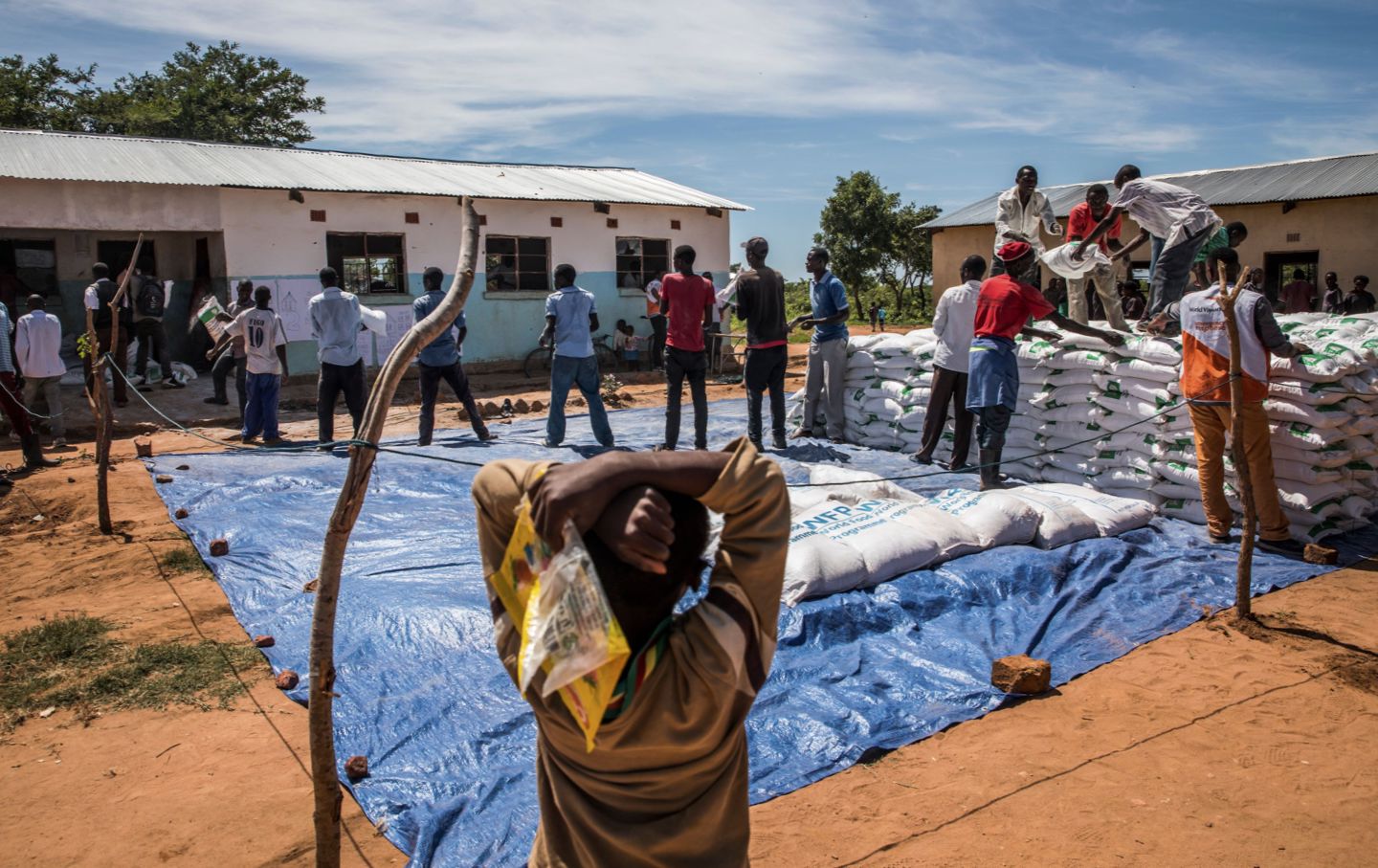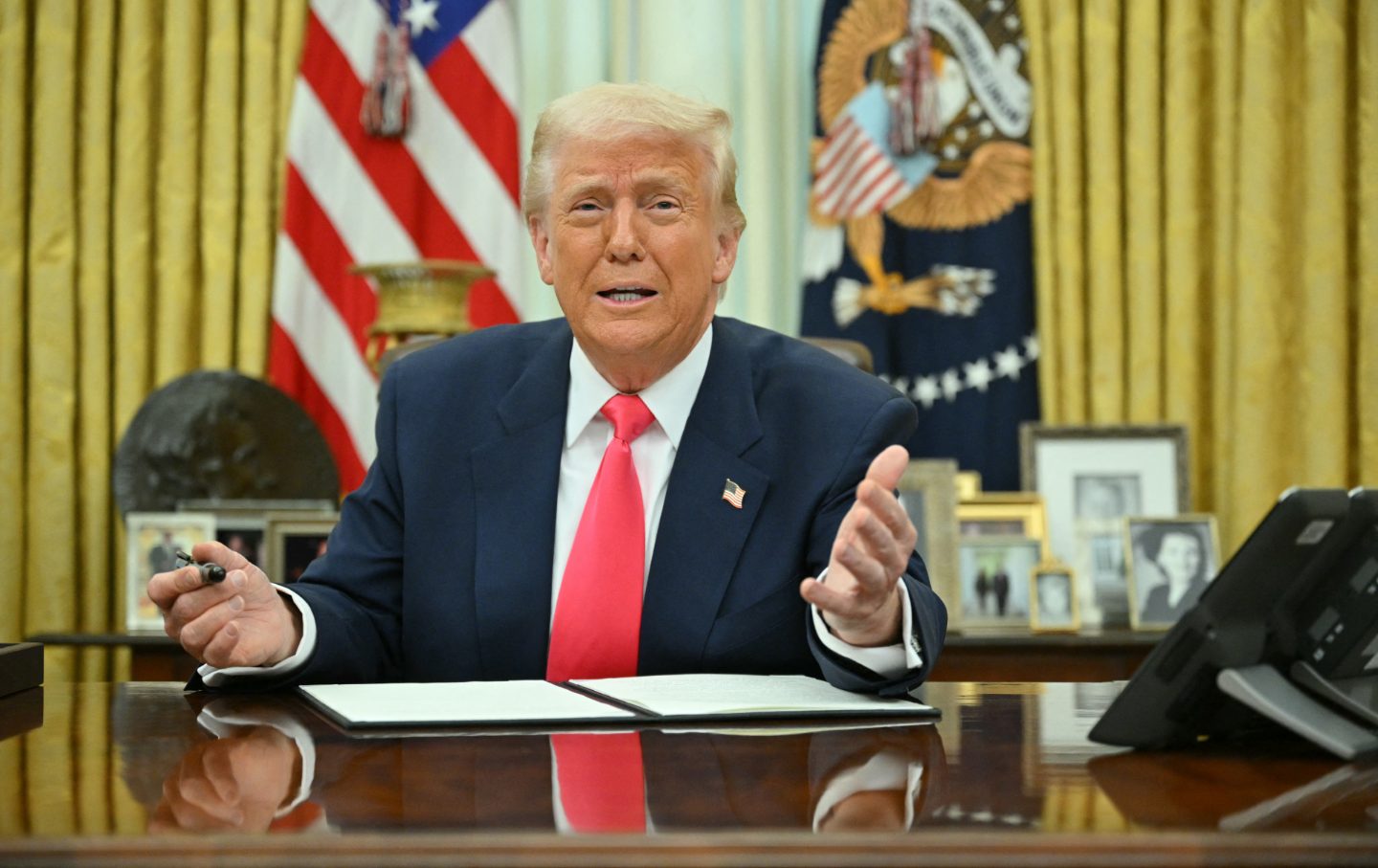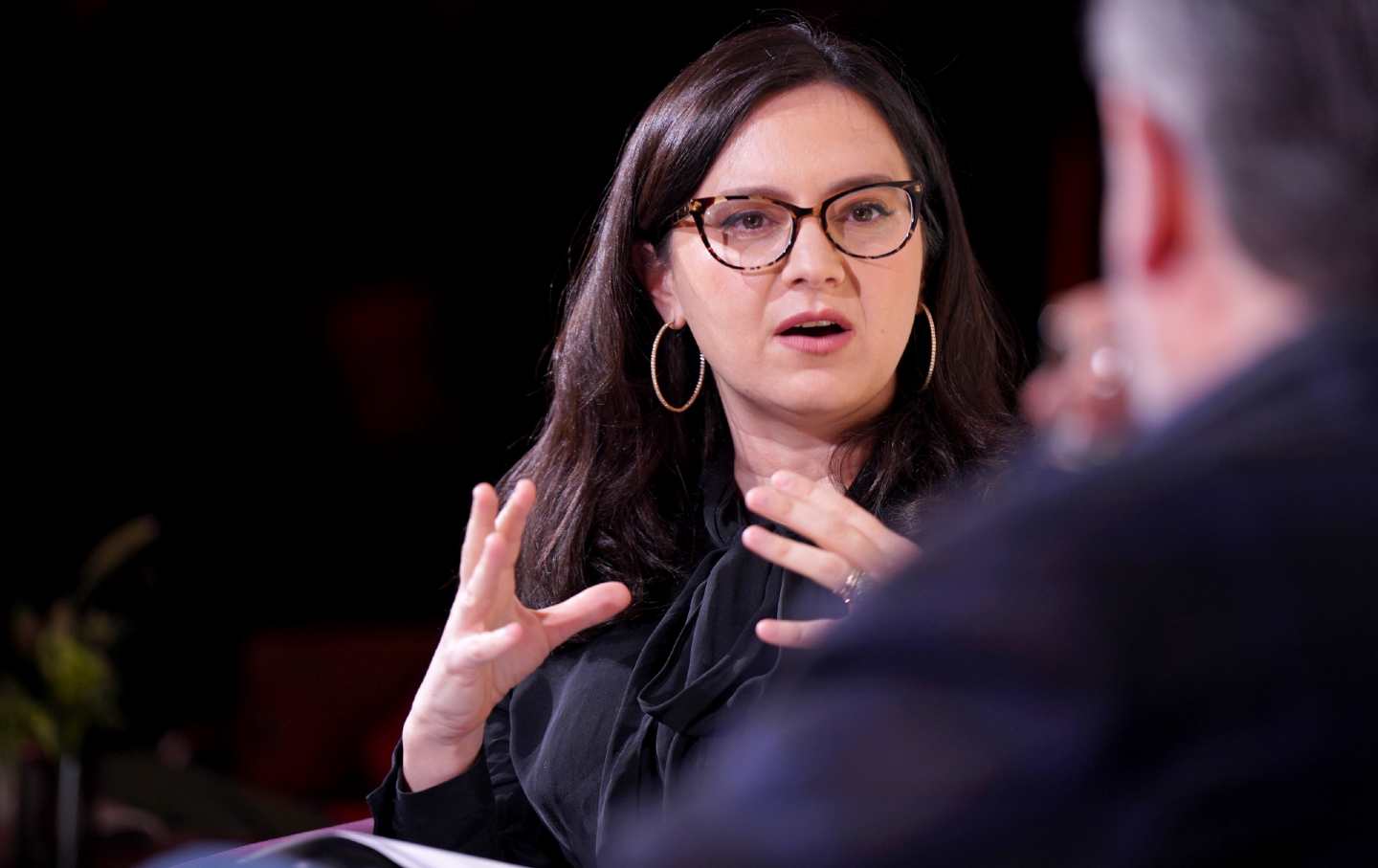Copper Colonialism Is Wrecking Zambia’s Farmlands and Waterways
Zambia is just one of several nations experiencing a new type of colonialism, this time with a green capitalist veneer.

Volunteers help distribute meal bags in Zambia during a severe drought.
(Guillem Sartorio / AFP)
This article originally appeared at TomDispatch.com. To stay on top of important articles like these, sign up to receive the latest updates from TomDispatch.com.
Considered Angola’s crown jewel by many, Lobito is a colorful port city on the country’s scenic Atlantic coast where a nearly five-kilometer strip of land creates a natural harbor. Its white-sand beaches, vibrant blue waters, and mild tropical climate have made Lobito a tourist destination in recent years. Yet under its shiny new facade is a history fraught with colonial violence and exploitation.
The Portuguese were the first Europeans to lay claim to Angola in the late 16th century. For nearly four centuries, they didn’t relent until a bloody, 27-year civil war with anticolonial guerillas (aided by the Cuban Revolutionary Armed Forces) and bolstered by a leftist coup in distant Lisbon, Portugal’s capital, overthrew that colonial regime in 1974.
Lobito’s port was the economic heart of Portugal’s reign in Angola, along with the meandering 1,866-kilometer Benguela Railway, which first became operational in the early 1900s. For much of the 20th century, Lobito was the hub for exporting to Europe agricultural goods and metals mined in Africa’s Copperbelt. Today, the Copperbelt remains a resource-rich region encompassing much of the Democratic Republic of Congo and northern Zambia.
Perhaps it won’t shock you to learn that, half a century after Portugal’s colonial control of Angola ended, neocolonialism is now sinking its hooks into Lobito. Its port and the Benguela Railway, which travels along what’s known as the Lobito Corridor, have become a key nucleus of China’s and the Western world’s efforts to transition from fossil fuels to renewable energy sources in our hot new world. If capitalist interests continue to drive this crucial transition, which is all too likely, while global energy consumption isn’t scaled back radically, the amount of critical minerals needed to power the global future remains unfathomable. The World Economic Forum estimates that 3 billion tons of metals will be required. The International Energy Forum estimates that to meet the global goals of radically reducing carbon emissions, we’ll also need between 35 and 194 massive copper mines by 2050.
It should come as no surprise that most of the minerals from copper to cobalt needed for that transition’s machinery (including electric batteries, wind turbines, and solar panels) are located in Latin America and Africa. Worse yet, more than half (54 percent) of the critical minerals needed are on or near Indigenous lands, which means the most vulnerable populations in the world are at the most significant risk of being impacted in a deeply negative fashion by future mining and related operations.
When you want to understand what the future holds for a country in the “developing” world, as economists still like to call such regions, look no further than the International Monetary Fund (IMF). “With growing demand, proceeds from critical minerals are poised to rise significantly over the next two decades,” reports the IMF. “Global revenues from the extraction of just four key minerals—copper, nickel, cobalt, and lithium—are estimated to total $16 trillion over the next 25 years. Sub-Saharan Africa stands to reap over 10 percent of these accumulated revenues, which could correspond to an increase in the region’s GDP by 12 percent or more by 2050.”
Sub-Saharan Africa alone is believed to contain 30 percent of the world’s total critical mineral reserves. It’s estimated that the Congo is responsible for 70 percent of global cobalt output and approximately 50 percent of the globe’s reserves. In fact, the demand for cobalt, a key ingredient in most lithium-ion batteries, is rapidly increasing because of its use in everything from cell phones to electric vehicles. As for copper, Africa has two of the world’s top producers, with Zambia accounting for 70 percent of the continent’s output. “This transition,” adds the IMF, “if managed properly, has the potential to transform the region.” And, of course, it won’t be pretty.
While such critical minerals might be mined in rural areas of the Congo and Zambia, they must reach the international marketplace to become profitable, which makes Angola and the Lobito Corridor key to Africa’s booming mining industry.
In 2024, China committed $4.5 billion to African lithium mines alone and another $7 billion to investments in copper and cobalt mining infrastructure. In the Congo, for example, China controls 70 percent of the mining sector.
Having lagged behind that country’s investments in Africa for years, the United States is now looking to make up ground.
Zambia’s Copper Colonialism
In September 2023, on the sidelines of the G20 meeting in India, Secretary of State Antony Blinken quietly signed an agreement with Angola, Zambia, the Democratic Republic of Congo, and the European Union to launch the Lobito Corridor project. There wasn’t much fanfare or news coverage, but the United States had made a significant move. Almost 50 years after Portugal was forced out of Angola, the West was back, offering a $4 billion commitment and assessing the need to update the infrastructure first built by European colonizers. With a growing need for critical minerals, Western countries are now setting their sights on Africa and its green energy treasures.
“We meet at a historic moment,” President Joe Biden said as he welcomed Angolan President João Lourenço to Washington last year. Biden then called the Lobito project the “biggest US rail investment in Africa ever” and affirmed the West’s interest in what the region might have to offer in the future. “America,” he added, “is all in on Africa.… We’re all in with you and Angola.”
Both Africa and the United States, Biden was careful to imply, would reap the benefits of such a coalition. Of course, that’s precisely the kind of rhetoric we can expect when Western (or Chinese) interests are intent on acquiring the resources of the Global South. If this were about oil or coal, questions and concerns would undoubtedly be raised regarding America’s regional intentions. Yet, with the fight against climate change providing cover, few are considering the geopolitical ramifications of such a position—and even fewer acknowledging the impacts of massively increased mining on the continent.
In his book Cobalt Red, Siddharth Kara exposes the bloody conditions cobalt miners in the Congo endure, many of them children laboring against their will for days on end, with little sleep and under excruciatingly abusive conditions. The dreadful story is much the same in Zambia, where copper exports account for more than 70 percent of the country’s total export revenue. A devastating 126-page report by Human Rights Watch (HRW) from 2011 exposed the wretchedness inside Zambia’s Chinese-owned mines: 18-hour work days, unsafe working environments, rampant anti-union activities, and fatal workplace accidents. There is little reason to believe it’s much different in the more recent Western-owned operations.
“Friends tell you that there’s a danger as they’re coming out of shift,” a miner who was injured while working for a Chinese company told HRW. “You’ll be fired if you refuse, they threaten this all the time.… The main accidents are from rock falls, but you also have electrical shocks, people hit by mining trucks underground, people falling from platforms that aren’t stable.… In my accident, I was in a loading box. The mine captain…didn’t put a platform. So when we were working, a rock fell down and hit my arm. It broke to the extent that the bone was coming out of the arm.”
An explosion at one mine killed 51 workers in 2005 and things have only devolved since then. Ten workers died in 2018 at an illegal copper extraction site. In 2019, three mineworkers were burned to death in an underground shaft fire and a landslide at an open-pit copper mine in Zambia killed more than 30 miners in 2023. Despite such horrors, there’s a rush to extract ever more copper in Zambia. As of 2022, five gigantic open-pit copper mines were operating in the country, and eight more underground mines were in production, many of which are to be further expanded in the years ahead. With new US-backed mines in the works, Washington believes the Lobito Corridor may prove to be the missing link needed to ensure Zambian copper will end up in green energy goods consumed in the West.
AI Mining for AI Energy
The office of KoBold Metals in quaint downtown Berkeley, California, is about as far away from Zambia’s dirty mines as you can get. Yet, at KoBold’s nondescript headquarters, which sits above a row of trendy bars and restaurants, a team of tech entrepreneurs diligently work to locate the next big mine operation in Zambia using proprietary Artificial Intelligence (AI). Backed by billionaires Bill Gates and Jeff Bezos, KoBold bills itself as a green Silicon Valley machine, committed to the world’s green energy transition (while turning a nice profit).
It is in KoBold’s interest, of course, to secure the energy deposits of the future because it will take an immense amount of energy to support their artificially intelligent world. A recent report by the International Energy Agency estimates that, in the near future, electricity usage by AI data centers will increase significantly. As of 2022, such data centers were already utilizing 460 terawatt hours (TWh) but are on pace to increase to 1,050 TWh by the middle of the decade. To put that in perspective, Europe’s total energy consumption in 2023 was around 2,700 TWh.
“Anyone who’s in the renewable space in the western world…is looking for copper and cobalt, which are fundamental to making electric vehicles,” Mfikeyi Makayi, chief executive of KoBold in Zambia, explained to the Financial Times in 2024. “That is going to come from this part of the world and the shortest route to take them out is Lobito.”
Popular
“swipe left below to view more authors”Swipe →Makayi wasn’t beating around the bush. The critical minerals in KoBold mines won’t end up in the possession of Zambia or any other African country. They are bound for Western consumers alone. KoBold’s CEO Kurt House is also honest about his intentions: “I don’t need to be reminded again that I’m a capitalist,” he’s been known to quip.
In July 2024, House rang his company’s investors with great news: KoBold had just hit the jackpot in Zambia. Its novel AI tech had located the largest copper find in more than a decade. Once running, it could produce upwards of 300,000 tons of copper annually—or, in the language investors understand, the cash will soon flow. As of late summer 2024, one ton of copper on the international market cost more than $9,600. Of course, KoBold has gone all in, spending $2.3 billion to get the Zambian mine operable by 2030. Surely, KoBold’s investors were excited by the prospect, but not everyone was as thrilled as them.
“The value of copper that has left Zambia is in the hundreds of billions of dollars. Hold that figure in your mind, and then look around yourself in Zambia,” says Zambian economist Grieve Chelwa. “The link between resource and benefit is severed.”
Not only has Zambia relinquished the benefits of such mineral exploitation, but—consider it a guarantee—its people will be left to suffer the local mess that will result.
The Poisoned River
Konkola Copper Mines (KCM) is today the largest ore producer in Zambia, ripping out a combined 2 million tons of copper a year. It’s one of the nation’s largest employers, with a brutally long record of worker and environmental abuses. KCM runs Zambia’s largest open-pit mine, which stretches for seven miles. In 2019, the British-based Vedanta Resources acquired an 80 percent stake in KCM by covering $250 million of that company’s debt. Vedanta has deep pockets and is run by Indian billionaire Anil Agarwal, affectionately known in the mining world as “the Metal King.”
One thing should be taken for granted: You don’t become the Metal King without leaving entrails of toxic waste on your coattails. In India, Agarwal’s alumina mines have polluted the lands of the Indigenous Kondh tribes in Orissa Province. In Zambia, his copper mines have wrecked farmlands and waterways that once supplied fish and drinking water to thousands of villagers.
The Kafue River runs for more than 1,500 kilometers, making it Zambia’s longest river and now probably its most polluted as well. Going north to south, its waters flow through the Copperbelt, carrying with them cadmium, lead, and mercury from KCM’s mine. In 2019, thousands of Zambian villagers sued Vedanta, claiming its subsidiary KCM had poisoned the Kafue River and caused insurmountable damage to their lands.
The British Supreme Court then found Vedanta liable, and the company was forced to pay an undisclosed settlement, likely in the millions of dollars. Such a landmark victory for those Zambian villagers couldn’t have happened without the work of Chilekwa Mumba, who organized communities and convinced an international law firm to take up the case. Mumba grew up in the Chingola region of Zambia, where his father worked in the mines.
“[T]here was some environmental degradation going on as a result of the mining activities. As we found, there were times when the acid levels of water was so high,” explained Mumba, the 2023 African recipient of the prestigious Goldman Environmental Prize. “So there were very specific complaints about stomach issues from children. Children just really wander around the villages and if they are thirsty, they don’t think about what’s happening, they’ll just get a cup and take their drink of water from the river. That’s how they live. So they’ll usually get diseases. It’s hard to quantify, but clearly the impact was there.”
Sadly enough, though, despite that important legal victory, little has changed in Zambia, where environmental regulations remain weak and nearly impossible to enforce, which leaves mining companies like KCM to regulate themselves. A 2024 Zambian legislative bill seeks to create a regulatory body to oversee mining operations, but the industry has pushed back, making it unclear if it will ever be signed into law. Even if the law does pass, it may have little real-world impact on mining practices there.
The warming climate, at least to the billionaire mine owners and their Western accomplices, will remain an afterthought, as well as a justification to exploit more of Africa’s critical minerals. Consider it a new type of colonialism, this time with a green capitalist veneer. There are just too many AI programs to run, too many tech gadgets to manufacture, and too much money to be made.
Support independent journalism that exposes oligarchs and profiteers
Donald Trump’s cruel and chaotic second term is just getting started. In his first month back in office, Trump and his lackey Elon Musk (or is it the other way around?) have proven that nothing is safe from sacrifice at the altar of unchecked power and riches.
Only robust independent journalism can cut through the noise and offer clear-eyed reporting and analysis based on principle and conscience. That’s what The Nation has done for 160 years and that’s what we’re doing now.
Our independent journalism doesn’t allow injustice to go unnoticed or unchallenged—nor will we abandon hope for a better world. Our writers, editors, and fact-checkers are working relentlessly to keep you informed and empowered when so much of the media fails to do so out of credulity, fear, or fealty.
The Nation has seen unprecedented times before. We draw strength and guidance from our history of principled progressive journalism in times of crisis, and we are committed to continuing this legacy today.
We’re aiming to raise $25,000 during our Spring Fundraising Campaign to ensure that we have the resources to expose the oligarchs and profiteers attempting to loot our republic. Stand for bold independent journalism and donate to support The Nation today.
Onward,
Katrina vanden Heuvel
Editorial Director and Publisher, The Nation
More from The Nation

Trump’s Order Dismantling the Education Department Continues His Attacks on the Agency Trump’s Order Dismantling the Education Department Continues His Attacks on the Agency
The president plans to sign an executive order directing officials to take all “necessary steps” to shut down the department, but a complete closure would require an act of Congre...

A Step-by-Step Guide to Trump’s Deportation Machine A Step-by-Step Guide to Trump’s Deportation Machine
October 17, 2024 Copper Colonialism Is Wrecking Zambia’s Farmlands and Waterways The machinery of mass deportation is meant to be impossible to stop. But any machine can be brought…

How a Case From 1803 Explains John Roberts’s Approach to Donald Trump How a Case From 1803 Explains John Roberts’s Approach to Donald Trump
Roberts wasn’t “rebuking” Trump when he issued his statement against impeaching judges. He was bending the knee.

How a Free-Speech University Sidles Up to Orbán’s Strongman Rule How a Free-Speech University Sidles Up to Orbán’s Strongman Rule
Bari Weiss's University of Austin, touted as a haven for free academic inquiry, has a dozen scholars and officials with ties to Hungary's speech-suppressing regime

Our Trans Protections Aren’t Strong Enough for the Trump Era Our Trans Protections Aren’t Strong Enough for the Trump Era
Many states have passed so-called “shield laws” to protect trans people. But they weren’t designed for a presidency like Donald Trump’s.

The Wisconsin Supreme Court Race Has Become All About Elon Musk The Wisconsin Supreme Court Race Has Become All About Elon Musk
The richest man in the world is the biggest spender on behalf of a right-wing effort to take control of a state Supreme Court.


